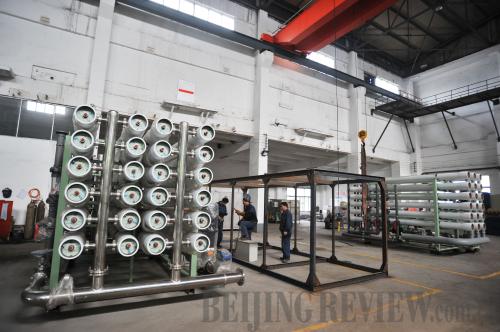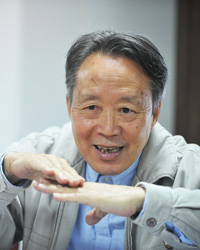|
 |
|
FROM SEAWATER TO DRINKABLE WATER: Workers at Boying Science and Technology Co. Ltd. install water desalination equipment to be donated to Sansha, Hainan Province, on November 29 (WEI YAO) |
 |
|
WITH FULL ZEST: Chen Liyi, chief engineer at Boying Science and Technology Co. Ltd., introduces the company's key technology (WEI YAO) |
"Imagine you are at the railway station, waiting in line to buy train tickets," said Chen Liyi. "There are millions of people waiting in line and millions of tickets available. However, there is only one window open for sales. The line moves really slowly and you have to be served."
Chen used a metaphor to elaborate on a key technology—the nanometer (nano) catalyst electrolysis. The 73-year-old is chief engineer at Boying Science and Technology Co. Ltd. and a retired professor from Xiamen-based Jimei University.
The analogy is a perfect description for the normal speed of electrolysis. However, if materials are produced at the nano scale (a nano is a unit of length in the metric system, equal to one billionth of a meter), the speed of a chemical reaction will be greatly enhanced because the catalytic surface area has been expanded. It's like opening thousands of windows to greatly improve the speed of ticket sales, said Chen.
Boying has also invented a technique, using nano technology, to increase the catalytic surface area of each electrode so that all seawater that runs through the electrode will be filtered more quickly.
The firm is a Xiamen-based hi-tech company engaged in seawater desalination, seawater cleaning and sewage disposal. Established in 2006, the company now has over 110 employees and over 91 patents in hand.
As the electrode process produces free radicals, it can quickly kill germs and viruses in seawater. Boying's nanometer catalyst electrolysis improves upon the process, which is why it's now widely used in Xiamen for swimming pool sanitization and maintaining a healthy aquaculture industry.
The Oceans and Fisheries Bureau of Xiamen has a seawater swimming pool, but it is constantly infiltrated by seaweed. By using Boying's nano catalyst electrolysis, the water became clean and clear, said Chen.
The aquaculture industry also benefits from Boying's technology.
The Fisheries College of Jimei University is studying fish breeding in seawater, but sanitation has been a problem.
Traditionally, adding disinfectant to the seawater at a cost of 0.6 yuan ($0.096) per ton was a common method. But fish contamination became a problem, not to mention the high cost. Marked progress was made after the college adopted Boying's seawater sanitization technology.
"By using Boying's nano catalyst electrolysis technology, germs and viruses can be eliminated very quickly, and the cost is only 0.035 yuan ($0.006) per ton of seawater," said Chen. "Besides, no harm is caused to the fish."
Another usage of nano catalyst electrolysis is the pretreatment of seawater desalination, a key area that Boying is focusing on.
Boying uses a reverse osmosis film to extract pure water from seawater. However, the film is often faced with microorganisms, making it more difficult for pure water to pass through on the other end.
To solve the problem, Boying uses nano catalyst electrolysis technology to electrolyze the microorganism in order to desalinate the seawater. No chemical agent is used in the process.
"It's also more economical," said Chen. "The energy consumption for desalinating each ton of seawater is 6-8 kw hours. Also, the larger the amount, the less it costs."
| 